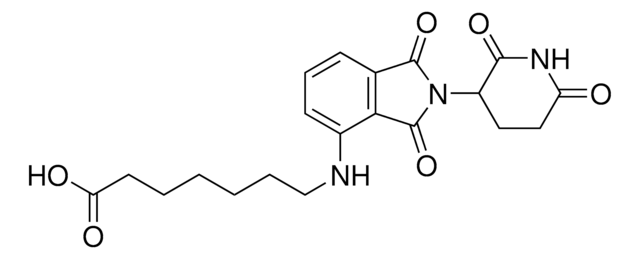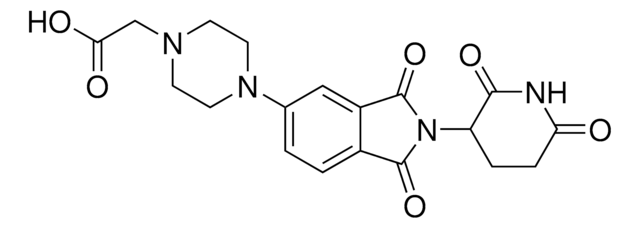929336
Pomalidomide-C5-phosphoramidite
Sinônimo(s):
2-Cyanoethyl (5-((2-(2,6-dioxopiperidin-3-yl)-1,3-dioxoisoindolin-4-yl)amino)pentyl) diisopropylphosphoramidite
About This Item
Produtos recomendados
ligand
pomalidomide
Nível de qualidade
Formulário
powder
temperatura de armazenamento
2-8°C
cadeia de caracteres SMILES
O=C1C2=C(C(NCCCCCOP(OCCC#N)N(C(C)C)C(C)C)=CC=C2)C(N1C3C(NC(CC3)=O)=O)=O
InChI
1S/C27H38N5O6P/c1-18(2)32(19(3)4)39(38-17-9-14-28)37-16-7-5-6-15-29-21-11-8-10-20-24(21)27(36)31(26(20)35)22-12-13-23(33)30-25(22)34/h8,10-11,18-19,22,29H,5-7,9,12-13,15-17H2,1-4H3,(H,30,33,34)
chave InChI
LDWPFUQTEOHLBX-UHFFFAOYSA-N
Categorias relacionadas
Aplicação
Technology Spotlight: Degrader Building Blocks for Targeted Protein Degradation
Protein Degrader Building Blocks
Outras notas
Destruction of DNA-Binding Proteins by Programmable Oligonucleotide PROTAC (O′PROTAC): Effective Targeting of LEF1 and ERG
Small-Molecule PROTACS: New Approaches to Protein Degradation
Targeted Protein Degradation: from Chemical Biology to Drug Discovery
Impact of linker length on the activity of PROTACs
Informações legais
Palavra indicadora
Danger
Frases de perigo
Declarações de precaução
Classificações de perigo
Repr. 1B
Código de classe de armazenamento
6.1C - Combustible acute toxic Cat.3 / toxic compounds or compounds which causing chronic effects
Classe de risco de água (WGK)
WGK 3
Ponto de fulgor (°F)
Not applicable
Ponto de fulgor (°C)
Not applicable
Escolha uma das versões mais recentes:
Certificados de análise (COA)
Não está vendo a versão correta?
Se precisar de uma versão específica, você pode procurar um certificado específico pelo número do lote ou da remessa.
Já possui este produto?
Encontre a documentação dos produtos que você adquiriu recentemente na biblioteca de documentos.
Nossa equipe de cientistas tem experiência em todas as áreas de pesquisa, incluindo Life Sciences, ciência de materiais, síntese química, cromatografia, química analítica e muitas outras.
Entre em contato com a assistência técnica








![4-Cyano-4-[(dodecylsulfanylthiocarbonyl)sulfanyl]pentanoic acid 97% (HPLC)](/deepweb/assets/sigmaaldrich/product/structures/204/925/30ae6ca0-5b0b-4963-a061-7e5e3d1a85af/640/30ae6ca0-5b0b-4963-a061-7e5e3d1a85af.png)
